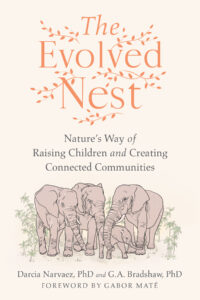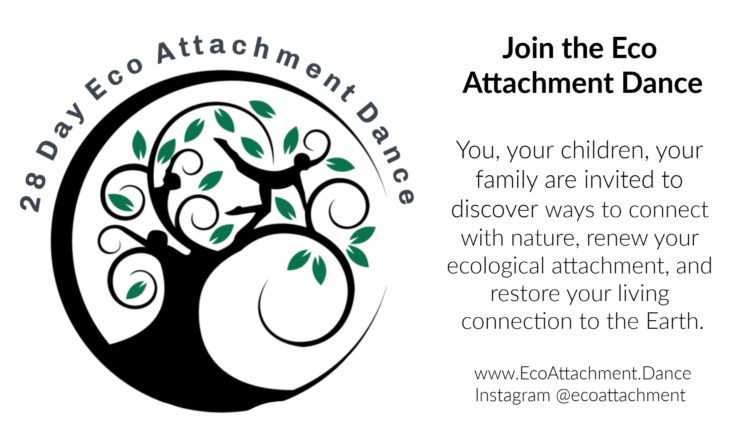Nurturing Genius in Children through Nature Connection
Growing our humanity requires Nature immersion.
One of the most important aspects of growing a human being is the establishment of a deep connection to Earth, helping children fall in love with their landscape. In recent decades, many children (and adults) have missed this opportunity by spending too much time inside four walls, in front of screens, away from a living, other-than-human environment. As a result, the bonding and the receptive intelligence needed to live with other than humans does not develop to the degree necessary to feel a sense of community with the landscape. Receptive intelligence includes a camaraderie and conviviality with the living, sentient members of Earth’s community.
 Growing up inside walls or screens represents a poverty unknown to our ancestors. The extinction of experience (Robert Michael Pyle’s term), which includes a lack of evolved nest experience as well as Nature immersion that contribute to a general lack of connection, is commonplace in industrialized societies. A de-Natured childhood leads to a brittle adulthood, one that feels disconnected from Nature, self, and other people. People become accustomed to the often ugly, impoverished settings of human-made environments. They become blind to the deteriorating habitat around them, not missing what they have not directly experienced—e.g., the beauty of a chorus of diverse birdsong or the majesty of an intact forest.
Growing up inside walls or screens represents a poverty unknown to our ancestors. The extinction of experience (Robert Michael Pyle’s term), which includes a lack of evolved nest experience as well as Nature immersion that contribute to a general lack of connection, is commonplace in industrialized societies. A de-Natured childhood leads to a brittle adulthood, one that feels disconnected from Nature, self, and other people. People become accustomed to the often ugly, impoverished settings of human-made environments. They become blind to the deteriorating habitat around them, not missing what they have not directly experienced—e.g., the beauty of a chorus of diverse birdsong or the majesty of an intact forest.
Further, schooling that ignores the place, the landscape, where the children are learning, teaches them that the landscape does not matter. The rest of Nature is unimportant and can be ignored. See prior post.
Nature helps raise us. Let’s remember that humans are part of a billions-year-old planetary family full of individuals interacting in flowing relations. We are not fully human apart from the natural world. We become shells of our potential selves without psychic entanglement with Nature. The beauty of wild Nature entrances us and helps us learn to accommodate difference, sensory variety, and changing circumstances. We adapt to the changing seasons and learn to dress and move appropriately for the weather, rather than adjusting the thermostat.
Nature is the seat of our happiness. With place-based education, we learn our landscape, its changes across seasons, attending to the wellbeing of the plants and animals it hosts. We feel how we are interwoven with the natural world around us. The winds and sun touch our skin. With permission, we touch our relations, the trees and plants. Our feet dance on the earth, even on the concrete or asphalt made from Earth.
Nature is relational, unified presence, we just have to open ourselves to it. Attunement to Nature means entering the flow of being in which animals, plants, and wind exist together. Children are ready to be open and perceive holistically. They need freedom in Nature, along with enthusiastic mentoring, to fully develop their Nature intuition, their animal mind. The animal mind is billions of years old, its genius inherent in all of us.
Here are some specific ideas:
- Carry children around the natural world, drawing their attention to different aspects—the moon, the hummingbird, the bark of a tree.
- Place babies outdoors where they can observe the natural world at play—light and shadows, breezes interacting with trees and bushes, birds and insects.
- Let toddlers explore Nature’s entities. Let them touch and feel (and connect!)
- Around age four, start send children outdoors with questions or tasks. ‘Find me’ an oak leaf, a pinecone, a pretty stone. In wildlife rich areas, it could be a frog or an insect (provide a jar), then after discussing the find, tell the child to return the animal to the place where it was gifted.
- Receive the child’s stories of their sightings or adventures. Listen enthusiastically, nonjudgmentally. Encourage the child to act out their story adventure with their full body.
- Encourage multisensory experience rather than naming and labeling and separating the natural world into objects. Ask questions: what did you hear? What did your feet feel? What did you smell? Who did you see? Children often see animals as active individuals, not as members of a category. Encourage this personal knowledge. Let children experiencing a science of wholes instead of a science of parts.
- Generally, let children play outdoors unsupervised, ideally with other children of multiple ages. Don’t watch too closely or you will interfere in their risk taking, which they need to do.
- During middle childhood and teen years, you can teach them wilderness survival skills (Long, 2011). They can learn competencies that build their confidence in themselves and their ability to live on Earth, beyond our walled-in existence.
Each of us is prewired to connect to the natural world and grow our energy and intelligence. We can do this at any time in life but is especially important for children when their brains and body-sense are under development. This inner vitality of deep connection activates with the right nutrients. The nutrients include: (1) extensive, uninterrupted adventures in wild or wild-like Nature, (2) reception of their stories by an enthusiastic listener, (3) a mentor who asks sensory-expanding questions, encourages more adventure and respectful interactions with the more-than-human.
Let’s raise the alpha generation to be Nature connected and responsible. Let’s save them from living their lives on screens. Let’s save them from despair.
Bibliography
Bowman, K. (2021). Grow wild: The whole-child, whole-family Nature-rich guide to moving more. Propriometrics Press.
Cohen, R.P. (2011). 15 minutes outside: 365 ways to get out of the house and connect with your kids. Naperville, IL: Sourcebooks.
Long, D. (2011). Survivor kid: A practical guide to wilderness survival. Chicago Review Press.
Louv, R. (2005). Last child in the woods: Saving our children from Nature Deficit Disorder. New York: Workman.
Louv, R. (2016). Vitamin N: The Essential Guide to a Nature-Rich Life: 500 Ways to Enrich Your Family’s Health & Happiness. Chapel Hill, NC: Algonquin Books.
Sampson, Scott D. (2015). How to raise a wild child: The art and science of falling in love with Nature. New York: Houghton Mifflin Harcourt.
Sobel, D. (2011). Wild play: Parenting adventures in the great outdoors. San Francisco: Sierra Club Books.
Young, J., Haas, E., & McGown, E. (2010). Coyote’s guide to connecting with nature, 2nd ed.. Santa Cruz, CA: Owlink Media.
Websites to check out:
https://www.davidsobelauthor.com/davidsobelbooks
https://www.internationalschoolgrounds.org/



